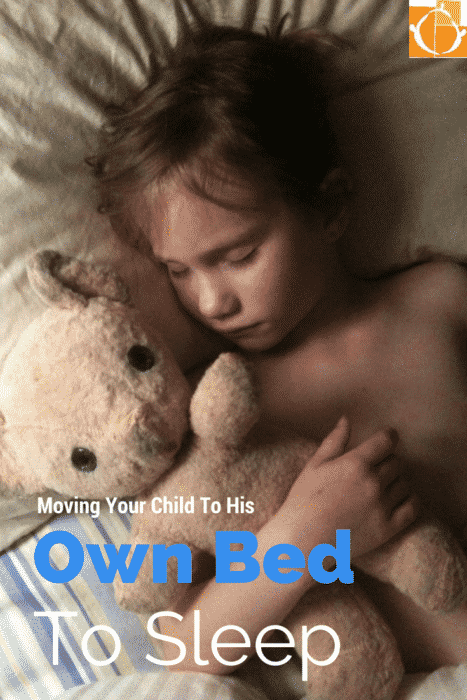Many of us sleep with our infants and children. We sleep with them because they love being close to us, and we (at least sometimes) also enjoy this closeness. Some of us sleep with our children, hoping it will bring us a better night’s sleep.

But at some point, the difficulties of sleeping together can outweigh the advantages and you may consider moving your child to his own bed. Perhaps your child is restless in the night; his night waking has become more frequent, instead of less; perhaps your bed is crowded; or importantly, the loss of privacy and intimate time with your spouse may have cooled your relationship.
We know that you want your child to feel safe at night, all night. We know it’s hard to figure out how to help your baby or your child gain “sleep confidence,” when he glues his little body to yours to soothe his fears. We know that some parents may judge you harshly for wanting to move your child out of your bed. Others have probably already expressed doubt that you were ever wise to allow your child into your bed. How confusing for us all!
You are considering taking a step that will very likely upset your child. And it’s OK.
We’ll show you how to help your child transition to his own bed in a way that will build his overall confidence. It can be done—many hundreds of Parenting by Connection parents have helped their children sleep on their own, without doing harm, and without breaking their child’s trust in them.
You can supportively wean a child from your bed beginning in infancy
 A note about the ages of the children we’re talking about. Our recommendations are geared for healthy children of about one year of age and older. If your baby was born prematurely, had a rough birth, has digestion issues, is underweight, or experienced trauma early on, he might benefit from the reassurance of a few more months of sleeping next to you. Check with your pediatrician about your baby, and be guided by his or her assessment.
A note about the ages of the children we’re talking about. Our recommendations are geared for healthy children of about one year of age and older. If your baby was born prematurely, had a rough birth, has digestion issues, is underweight, or experienced trauma early on, he might benefit from the reassurance of a few more months of sleeping next to you. Check with your pediatrician about your baby, and be guided by his or her assessment.
This article won’t discuss the timing of weaning your child from your family bed. We’ll leave the timing to you. We will say that if your child is healthy, but is waking in the night, demanding nursing an increasing number of times, is afraid to sleep alone, causes you to get broken sleep, or if you sense that you’re losing the joy in your spousal relationship, the Parenting by Connection process of weaning your child from your bed can help both you and your child greatly.
You need good quality sleep.
You do need sleep. When you must wake many times in the night, week after week, the sleep deprivation can frazzle your judgment, slow your reaction time, cloud your ability to think, and drain your patience and happiness. Your child needs a parent who is running on all cylinders. Your child needs an aware parent during the day.
How the family sleeps is not, by itself, a predictor of secure children
 At Hand in Hand, we support parents who want to sleep together as a family, as well as parents who don’t. In my own four decades of observation of families who have slept in a wide variety of ways, I started out convinced that one particular sleep choice would give children the strongest boost in the area of emotional security and sound judgment. But I found over time that I was mistaken. I knew many parents who adopted the family bed, and many others who tucked their children into their own cribs early in infancy. I have followed these children through adolescence and young adulthood. Whether they slept with their parents or slept in their own beds from infancy, they stayed in close contact with their parents. They became competent, smart, loving, creative adults.
At Hand in Hand, we support parents who want to sleep together as a family, as well as parents who don’t. In my own four decades of observation of families who have slept in a wide variety of ways, I started out convinced that one particular sleep choice would give children the strongest boost in the area of emotional security and sound judgment. But I found over time that I was mistaken. I knew many parents who adopted the family bed, and many others who tucked their children into their own cribs early in infancy. I have followed these children through adolescence and young adulthood. Whether they slept with their parents or slept in their own beds from infancy, they stayed in close contact with their parents. They became competent, smart, loving, creative adults.
What gave these young people the advantage of growing up sound and secure was having a parent or parents who were relatively well supported and well attuned to others. These parents knew how to listen to their children’s feelings. They used the Parenting by Connection Listening Tools regularly to help their children shed behaviors that weren’t working well in the family or at school. And these parents developed Listening Partners, people in their lives who they could turn to regularly to offload their own frustrations. Life for families isn’t easy. Emotional support for parents, who then offer emotional support to their children, is far more important than exactly how sleep is arranged. Close connection between parent and child is vital, and it is nurtured primarily during the day. Nighttime snuggles are frosting on the cake of a day full of interaction. If a parent is tired, worn, and frustrated, sleeping together won’t substitute for his or her lack of daytime enthusiasm for parenting.
Children collect lots of fears, and use physical closeness to keep them in check
It’s not easy being an infant or a young child. Lots of things happen that are surprising, overwhelming, or momentarily painful. From an infant’s point of view, your parents have to cook, clean, and earn a living, when all you want is for them to love you dearly, and play the whole day long. The world is loud, fast and unpredictable. So it’s easy to become frightened, and sad.
When infants and young children are struck by a big feeling like fear or grief, they try to tell their parents about it, and to heal from it. In the arms of a loved one, crying, having a tantrum, or writhing, sweating, screaming and trembling actually heals the hurt. If a parent can listen and pour in warmth and caring, the child can get rid of the feeling, and return to a contented, unafraid state of mind again.
Parents are taught to stop a child’s screaming or crying—the signals that big feelings are ready to be expressed and dissolved. We assume that our precious child might be hungry, or needs some jiggling to provide a distraction. So we try to soothe his crying with nursing (which is, of course, the appropriate thing to try with an infant, as crying also signals hunger or pain), and after he’s fed, with rocking, patting, singing, bouncing, pacifiers, scolding, time out or even physical punishment.
What we aren’t taught is that, when hunger or pain isn’t the issue, all the energy we put into stopping our children’s screams and cries has a drawback. If our child doesn’t get to work the bad feeling all the way through, with our support, that fear or sadness gets stored in their memory. Stored feelings make trouble for children. Unless a child is ill, it’s stored feelings that wake him in the night, that make him restless in bed, and that make him afraid to relax into sleep unless he can cling to you for comfort. Children don’t “grow out of” a set of stored feelings. The feelings take root and multiply, so that children harboring fear will wake once in the night, then twice, then three times. The child’s feelings beg for your attention.
You can help your child dissolve his feelings of fear and grief, so he can tell that he’s safe in his bed
What your frightened or sad child needs is to be able to cry or scream in the throes of that feeling, while you offer support and remember that there isn’t any danger present at all. Your child releases his upset by expressing it fully and passionately. Emotional release eventually allows your child to regain a peaceful state of mind. For a child who is releasing a big fear, this process of crying, struggling, sweating, arching, and trembling in the arms of a supportive parent can take awhile—even up to an hour!
As you pour in attention, listening and support, your child rids his mind of tension. The bad feeling finally passes, his mind clears, and he becomes content, and feels closer to you. He’s now less scared. He now carries less grief.
Staylisten when your child is sad or frightened. It will help him greatly.
We call the kind of listening that helps your child “Staylistening. “You stay very close, you pour all your love and attention into your child, and you let him throw himself into expressing those big feelings, until he feels safe in your arms. You give him your confidence that he’s safe, and that you’re watching over him. You anchor him while he has this emotional “bad dream,” and rids his mind of a big fear from some earlier time.
You don’t need to know what his feelings are, or where they come from. He’ll show you plenty about how he feels while he cries and struggles. He doesn’t need to name his feelings, and you should not do that for him. He needs your caring while he does his work. Once he has dissolved that big chunk of fear or grief, he’ll be able to fall asleep almost anywhere, and sleep the night through. He’ll be able to sleep with you when you are open to that, and to sleep by himself when that’s the best thing for the night. Both he and you will have a much better chance at having a good night’s sleep.
Your child’s bedtime ritual serves as a little lid on unruly feelings
Children use bedtime rituals—stories, placing your arms or hands “just so,” needing a pacifier or stuffed animal, and needing you close by—to keep their unprocessed feelings in check. Change one little thing at bedtime, and those feelings pop up out of hiding and begin to take over. So if a child is used to having Daddy read 3 stories, and Daddy proposes 2 stories, tears or a tantrum could easily follow. The child, in actuality, is safe in bed no matter how many stories are read, but he can’t tell. His fears or grief dictates how he feels. The 3 stories and the other little rituals help a child manage the feelings that arise at night.
So going from the family bed to his own bed will likely bring up some big feelings for your child. It’s best to think of this process as one that may have many steps. If you guide your child through with love and caring, he’ll have the time he needs to unburden those stored feelings, and he’ll be able to cooperate, eventually, in sleeping on his own. For some children whose lives have been relatively free of difficulty, the process can take three or four nights. For others, who have survived life-threatening circumstances, it can take much longer. You won’t know how long the path will be for your child as you embark, but long or short, the path starts out the same. Our article on How to Help Children Sleep Through the Night takes a closer look at what procrastination at bedtime looks like when you use staylistening.
Tell your child you’re going to help him to sleep in his own bed.
Even if your child is still an infant, I think it’s good to tell him, verbally, that you are going to help him to feel safe in his own bed. The attitude of respect you have for his intelligence is important. Children understand far more than we yet imagine. For instance, recent research shows that newborn infants prefer the language their parents speak to unfamiliar languages, having learned the sounds of what will be their native language in the womb. So share your decision to embark on this project with your child, whether he’s 4 months or 4 years old.
Begin by changing your child’s bedtime ritual just a bit.
Most children who are afraid to sleep in their own beds also become afraid when any part of their bedtime ritual is changed. So take one small step first. Change something that your child feels he “needs” when going to sleep. If he needs the light on, tell him that you’ll help him go to sleep in the dark. Or if he needs his teddy or pacifier, propose to put teddy on the nightstand, or his pacifier in a jar by his bedside. Just propose the change.
If the idea of change brings tears or tantrums, your child is already offloading the feelings that prevent him from feeling safe. Listen. Stay close. Offer eye contact, whether he looks at you or not. Hold him gently if he’s screaming or thrashing—this wild activity is what it takes to heal a big fear that has leapt out of emotional storage. Don’t ask him what he’s scared of. Don’t ask him to answer any questions at all. Just absorb what he’s telling you nonverbally. He needs you to see how hard this is, but your worry isn’t helpful to him. He’s sturdy. He’s built to offload feelings in this way. Just hang in there—he’s having a big, messy “emotional poop,” and it will continue until he doesn’t have more to release for tonight.
When his crying or thrashing slows, remind him that you want to turn out the light, or put his teddy on the nightstand, or put his pacifier in a jar nearby. That will start the feelings up again. You don’t have to do these things—he’s begun to shed fear or grief by working on the idea of doing those things, and that’s just fine. You’re not trying to “accomplish” anything, or to get to the next stage. Your goal is to support him while he cries about the idea you have proposed.
If your ability to listen wears out before your child stops crying, you can tell him that he’s done enough hard work for tonight, and that you’ll make the change tomorrow night. This is not giving in, and it’s not being inconsistent. It’s telling a child, “I can’t listen to your feelings any more. I won’t force you to make a change before you’re ready. So you can go to sleep now, and we’ll talk about putting your teddy on the nightstand tomorrow night.” Your child has shed some big feelings. There are more to be shed, and tomorrow is another day. If you find that tomorrow night, you don’t have the emotional wherewithal to do the Staylistening, then just wait to propose the little bedtime change, and listen, until you can support him well.
You will most likely need emotional support to Staylisten with full attention
It’s not easy to listen to our children wail and flail in fear. We don’t want them to hurt. We want to make life smooth and easy. Most of us have never ever seen a person dive into their feelings as fully as a child does. Children show every detail of their emotional pain. So it’s scary. It’s wearing. It’s unusual. It doesn’t look like a supportive thing to do. And other family members don’t always approve.
You’ll most likely need a listener for yourself, so you can offload your own fear and grief. You’ll need someone to care about how you feel, and to stay with you as you release your own set of upsets and worries. We have a booklet, Listening Partnerships for Parents, in our set of Listening to Children Booklets, which describes how two parents can team up to support one another in turn. It’s a simple thing to try, and there’s an art to listening that is interesting to refine. It makes such a difference to have someone to talk to about parenting, someone who won’t judge you, and who will let you explore your own mind and heart without interruption or advice. We highly recommend setting up a Listening Partnership, so you don’t exhaust yourself while trying to help your child. You’ll be a far better listener, and a far steadier emotional guide, if you have your own listener on a regular basis!
When your child can agree to the bedtime change, make it

Whether it’s five minutes or five nights, when the idea of making the change you’ve proposed doesn’t bring your child to tears or thrashing or tantrums, then he’ll be able to tell you that it’s OK to make the change. Do it. Enjoy your success for a few nights, and propose another change, working step by step until your child can fall asleep easily.
Take breaks in this emotional project for vacations, illnesses, and to lower your own stress levels. Just explain to your child, “Tonight I am not going to help you sleep with Teddy on the nightstand. I had a big day. I’ll help you another night.” Your child doesn’t need you to be consistent in how each bedtime goes. He just needs to know why things are different today. He needs a parent who can think, flex, and take present conditions into account, not a parent who tries hard to make one day look exactly like the next! After all, the days aren’t the same, and don’t need to be.
If your child wakes in the night, tackle that difficulty next.
Before your child will sleep deeply and securely in his own bed, he needs work through the fears that grab him in the middle of the night, or to tackle his dependency on nursing. A good way help him with the fears that break up his sleep is to Staylisten, rather than soothe or nurse him, when he wakes for the first time in the night. Make sure you feed him well before bed, to reassure yourself that he won’t starve. You can prepare a cup of milk or formula to offer him instead of his usual. Most children nurse or take a bottle to keep stored feelings under control, and not for the nourishment, so your child will most likely refuse the substitute nutrition.
When your child wakes, turn on a nightlight, so he can see your face, and can see the eye contact and gentle listening attitude you’re bringing to him. Don’t give him so much closeness that his feelings are tamped down. But do give him enough touch and reassurance to let him know you’re listening, caring, and protecting him.
For example, my grandson was rushed to Neonatal Intensive Care for treatment immediately after his birth. He couldn’t breathe on his own. He lay on a little table there, under warming lights, for the first 48 hours of his life. This was a lonely, frightening way start to his life.
We think it was fear from his hospital experience that made it impossible for him to sleep through the night. When his parents were nearly worn out from waking, they began to do extended Staylistening at his first waking each night. There were earplugs and a bed on the sofa for the parent who got to sleep through. The listener for the night would go to him in his crib (two feet from their bed). My grandson would stand up in his crib, pump up and down and cry hard. His dad would hold him close, but didn’t take him out of the crib. The crib slats were sandwiched between toddler and parent. His dad would gently murmur, “You’re safe. I’m right here. I’m watching over you every minute. I won’t stop protecting you.” And when my grandson’s crying would begin to taper down, his daddy would pat his bed, saying, “You can lie down right here and go to sleep. I’ll stay right here.” And my grandson would cry and tremble some more. Eventually, he would lose his need to cry, lie down, and fall asleep.
Because he had been in a life-threatening situation, getting rid of my grandson’s fears took awhile. Slowly, he progressed to sleeping peacefully through the night, and then, with more work, to sleeping in his own bed.
Work from one change to the next, Staylistening all the way, until your child reaches his own bed. You’ll see good progress along the way.
 Every cry, every thrashing episode shaves off another chunk of the fear that keeps your child from nodding off, sweetly and confidently. And those cries might free up other rigidities he’s burdened by, as well. After a crying episode, look for subtle signs that he’s got more confidence. He might sleep a little longer before waking. Or he might show sudden progress in acquiring language. He might tell you more of his thoughts. He might nap more easily during the day, or laugh more often, a sure sign that the strictures of fear are lifting. See what surprises in courage and affection your child might have for you.
Every cry, every thrashing episode shaves off another chunk of the fear that keeps your child from nodding off, sweetly and confidently. And those cries might free up other rigidities he’s burdened by, as well. After a crying episode, look for subtle signs that he’s got more confidence. He might sleep a little longer before waking. Or he might show sudden progress in acquiring language. He might tell you more of his thoughts. He might nap more easily during the day, or laugh more often, a sure sign that the strictures of fear are lifting. See what surprises in courage and affection your child might have for you.
It can happen that a child has a lot of stored feelings all lined up, and ready to be shed. So when you Staylisten for the first time, he cries long and hard, and some rocky days follow. He’s been waiting for you to understand his need for emotional release, and now that you have opened the floodgates, he’s having big cries or tantrums about lots of issues you thought he had outgrown. It can be hard when this happens—you were hoping for quick, positive results, and instead, you have a child who is now making an emotional issue out of the slightest thing. Be reassured that your child is OK. His instinct to offload the emotional burdens he’s been carrying is strong, and that soon, he’ll be more flexible, more playful, more eager to connect, and more affectionate. He’s taking full advantage of your intention to help.
Once your child is unafraid to sleep in his own bed, everyone in the family has relaxed sleeping choices. You can all sleep together when you want, and you can have separate beds when you want. Your child will be able to flex, and so will you. On the odd night that he’s clingy again, you’ll have learned to Staylisten, so he can get his emotional work done, and you can know that it’s a kindness to him to give him a chance to cry, feel your love, and offload the tensions of the day.
Vigorous Playlistening at bedtime will also build your child’s confidence
Contrary to what most parents believe, a good, laughter-filled physical playtime before bed is a great way to help your child connect securely with you. For brevity’s sake, I’ll refer you to our booklet called Playlistening, part of the Listening to Children booklet set, to learn more. The benefits of laughter and freewheeling physical play are many. Try a nightly wrestle, a pillow fight or a game of “Let me give you 100 kisses! Hey, wait, you’re getting away!” in which you fall to your hands and knees in a clumsy chase, while your child outfoxes you again and again. Land a few kisses, but barely. Notice what makes your child laugh, and do more of the same. Let your child be the victor in the end.
Laughter releases the lighter side of fear, and Playlistening, in which you promote laughter by taking the less powerful role, is a great way to bond with your child. Don’t tickle. Instead, feel free to nuzzle, bounce, snuggle, gently bump and roll and toss and fall in order to get laughter going. You can pretend to tickle, if your child begs for it. Just wiggle your fingers above his tummy, and let him laugh in anticipation—that way, he’s not trapped by you, and his laughter will do him the kind of good you intend.
You will learn much about your child’s resilience
 Most of us don’t begin parenting with the understanding that our children have their own innate way to recover from hurt feelings, fears, and overwhelming experiences. So when you decide to help your child feel safe in his own bed, at his pace, listening to his feelings along the way, you’ll see your child shed his fears completely. You’ll have the chance to change your child’s life. And we hope you will become familiar with the benefits of Listening Partnerships, so you aren’t trying to be Wonder Woman or Superman. You, like all parents, need a way to replenish your emotional energy and to offload the feelings that come with the challenge of parenting.
Most of us don’t begin parenting with the understanding that our children have their own innate way to recover from hurt feelings, fears, and overwhelming experiences. So when you decide to help your child feel safe in his own bed, at his pace, listening to his feelings along the way, you’ll see your child shed his fears completely. You’ll have the chance to change your child’s life. And we hope you will become familiar with the benefits of Listening Partnerships, so you aren’t trying to be Wonder Woman or Superman. You, like all parents, need a way to replenish your emotional energy and to offload the feelings that come with the challenge of parenting.
Here’s how it can work
My 6-year-old had always slept in the family bed. My husband and I felt it was time for him to be able to sleep in his own bed, which was only a step away from the “big bed.” So one night, I felt that I had the inner resources to Staylisten through what I guessed would be a big upset.
We went up to the bedroom, and he refused to get into his bed. I gave him a choice – either he come into his bed, or I could carry him. He still refused to move. So I gently put my hand on him and said, “I will help you come over.” He screamed, “No! No! No!” I listened, and then repeated that I would help him. He started kicking me and thrashing about. I managed to stay calm, but I had to hold his legs to keep myself safe. This made him really angry! “Not my legs,” he screamed, in between big sobs. At this point, I felt unsure. I wasn’t sure about whether I was doing the right thing by holding his legs. But I reasoned that I had to stop myself from getting hurt. At this point he was wild with rage.
I remembered a very traumatic experience from his infancy when he was held down to have stitches in his forehead. I had to hold his legs that day. I felt that me holding his legs again was triggering this very early trauma for him. Luckily, I had gotten lots of listening time about my own fears and sadness about that incident! I was able continue to hold his legs to insure my own safety, and to love him at the same time. I didn’t say much, but when I could, I reassured him that no one was going to hurt him today. That I loved him and that he was safe now.
After a while, he stopped thrashing and so I let go of his legs. I reminded him gently that I needed him to sleep in his own bed. He kicked again and I found myself again holding his legs and listening to him rage and scream. He ended up in a big sobbing cry in my arms, once the fury was spent.
I was then able to carry him into his bed. Twice he got up and ran to the big bed. I picked him up twice, bringing him back into his bed. He cried again, and told me he gets cold and lonely in his bed. At that point, I stayed with him in his bed. He was very tired. I told him that he is never alone, that my love is always there and that I was still looking after him although I would sleep in the other bed. I told him I loved him, to which he answered, “Well, I don’t love you.” I told him that I would keep on loving him, and that my love was always there. He drifted off to sleep and slept peacefully.
This night really helped me to see just how much fear he has carried with him for so many years. He presented two big emotional projects that night—sleeping in his bed, and recovering from his old fears from long ago. I felt so much compassion and love for him. I felt really close and connected to him for a few days after that. What an honour it was to witness such deep healing taking place!
Quite a few more Staylistening sessions around this issue followed. I am so pleased to say that he now sleeps in his own bed, and will stay there the whole night. In the morning, we get to have lots of cuddles, which we look forward to very much. All in all, it took about 2 weeks before he easily accepted that his bed was the place to be, and he is generally more relaxed than before. I sense that he feels lighter and easier in himself now that the big fear that he had held for so long has been listened to with love and understanding.
–a mother in Currumbin Valley, Queensland, Australia.


